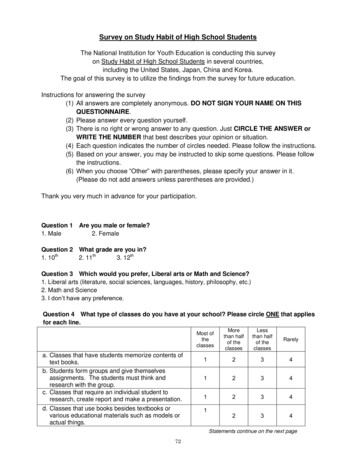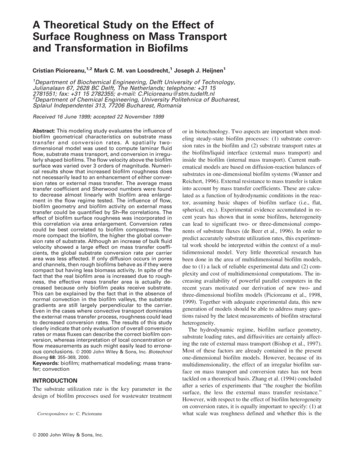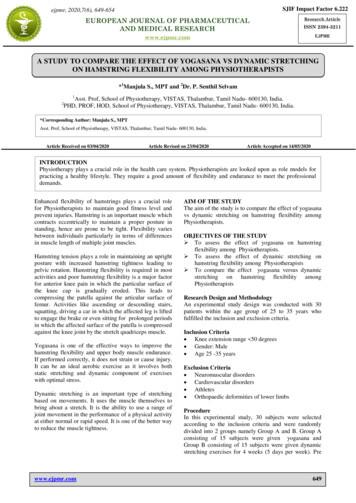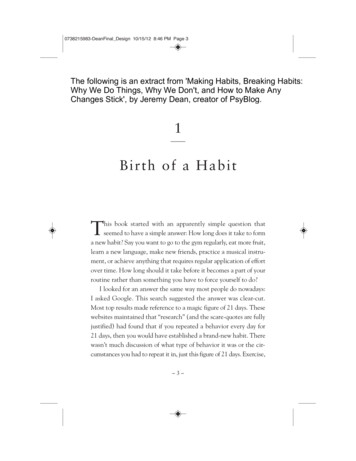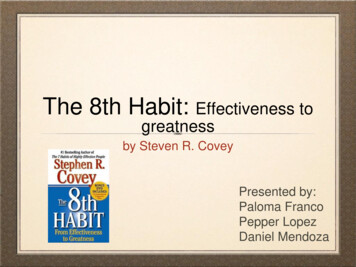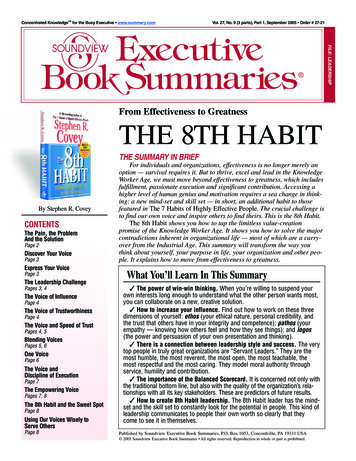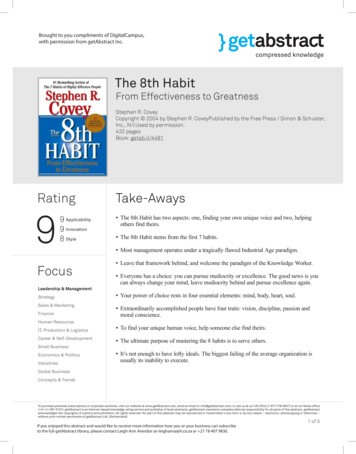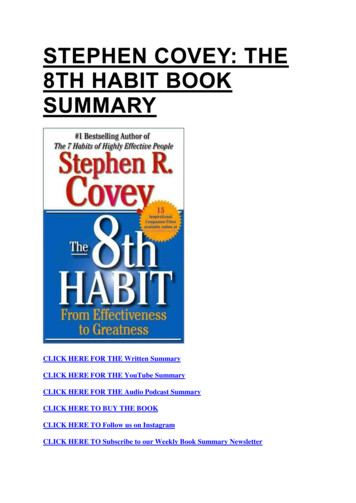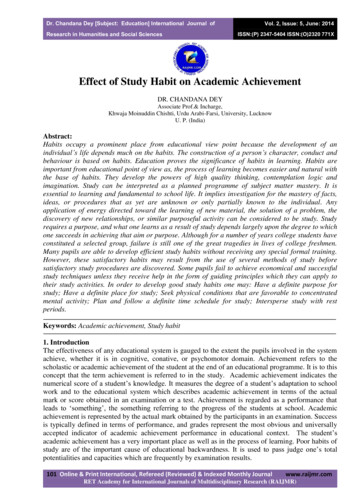
Transcription
Dr. Chandana Dey [Subject: Education] International Journal ofResearch in Humanities and Social SciencesVol. 2, Issue: 5, June: 2014ISSN:(P) 2347-5404 ISSN:(O)2320 771XEffect of Study Habit on Academic AchievementDR. CHANDANA DEYAssociate Prof.& Incharge,Khwaja Moinuddin Chishti, Urdu Arabi-Farsi, University, LucknowU. P. (India)Abstract:Habits occupy a prominent place from educational view point because the development of anindividual’s life depends much on the habits. The construction of a person’s character, conduct andbehaviour is based on habits. Education proves the significance of habits in learning. Habits areimportant from educational point of view as, the process of learning becomes easier and natural withthe base of habits. They develop the powers of high quality thinking, contemplation logic andimagination. Study can be interpreted as a planned programme of subject matter mastery. It isessential to learning and fundamental to school life. It implies investigation for the mastery of facts,ideas, or procedures that as yet are unknown or only partially known to the individual. Anyapplication of energy directed toward the learning of new material, the solution of a problem, thediscovery of new relationships, or similar purposeful activity can be considered to be study. Studyrequires a purpose, and what one learns as a result of study depends largely upon the degree to whichone succeeds in achieving that aim or purpose. Although for a number of years college students haveconstituted a selected group, failure is still one of the great tragedies in lives of college freshmen.Many pupils are able to develop efficient study habits without receiving any special formal training.However, these satisfactory habits may result from the use of several methods of study beforesatisfactory study procedures are discovered. Some pupils fail to achieve economical and successfulstudy techniques unless they receive help in the form of guiding principles which they can apply totheir study activities. In order to develop good study habits one may: Have a definite purpose forstudy; Have a definite place for study; Seek physical conditions that are favorable to concentratedmental activity; Plan and follow a definite time schedule for study; Intersperse study with restperiods.Keywords: Academic achievement, Study habit1. IntroductionThe effectiveness of any educational system is gauged to the extent the pupils involved in the systemachieve, whether it is in cognitive, conative, or psychomotor domain. Achievement refers to thescholastic or academic achievement of the student at the end of an educational programme. It is to thisconcept that the term achievement is referred to in the study. Academic achievement indicates thenumerical score of a student’s knowledge. It measures the degree of a student’s adaptation to schoolwork and to the educational system which describes academic achievement in terms of the actualmark or score obtained in an examination or a test. Achievement is regarded as a performance thatleads to ‘something’, the something referring to the progress of the students at school. Academicachievement is represented by the actual mark obtained by the participants in an examination. Successis typically defined in terms of performance, and grades represent the most obvious and universallyaccepted indicator of academic achievement performance in educational context. The student’sacademic achievement has a very important place as well as in the process of learning. Poor habits ofstudy are of the important cause of educational backwardness. It is used to pass judge one’s totalpotentialities and capacities which are frequently by examination results.101 Online & Print International, Refereed (Reviewed) & Indexed Monthly Journalwww.raijmr.comRET Academy for International Journals of Multidisciplinary Research (RAIJMR)
Dr. Chandana Dey [Subject: Education] International Journal ofResearch in Humanities and Social SciencesVol. 2, Issue: 5, June: 2014ISSN:(P) 2347-5404 ISSN:(O)2320 771X2. Correlation between Study Habits and Academic AchievementResearch on the correlation between study habit and student’s academic performance has for longreceived attention from scholars and educational agencies. Study habits are learning tendencies thatenable students to work individually. Study habits are measured directly through reports, examination,assessment and rating. Attitude towards study has a great contribution in academic achievement andgood study pattern. Successful learners adopt positive attitude towards study and do not waste time orenergy over what they have to do. If the learning experience is pleasant, the learner’s attitude andmotivation usually is positive and if the learning experience is not pleasant he tends to avoid. Studytechniques may be of extensive and intensive type. Extensive studying is related to reading aparticular text book, magazine or journal in order to have an idea of the basic information given in thematerial. Surveying and skimming has been identified as extensive studying technique. Intensivestudying on the other hand deals with reading a particular text book or course material in order toachieve full understanding of such material for the examination.3. Objectives of the studyThe main objective of this investigation is to study the relationship between Study Habits andAcademic Achievements of male and female and students of a University. The present study has beendesigned to achieve the following objectives : To carry out a comparative study of academic achievements of male and female students. To carry out the relationship between study habits and academic achievements of male andfemale students.4. HypothesisTo attain the proceeding objectives, the following hypotheses are proposed :Ho1: There is no significant difference between academic achievements of male and female students.Ho2: There is no significant relationship between study habits and academic achievements of maleand female students.5. Delimitations of the studyThe study is delimited to the determinants of study habits as influence on the academic performanceof male and female students of the University.6. PopulationThe population of this study included all the undergraduate and postgraduate students of theUniversity. The sample was selected on the basis systematic sampling. Students from differentdepartment i.e. Education, Commerce, Management, Computer Application, English, PhysicalEducation were included in the sample.7. Tools UsedIn order to measure the study habits, the study habit inventory by M.N. Palsane and AnuradhaSharma. Marks obtained in the university examinations in the first and second semester were taken asindicators of academic achievements.8. SampleFor this study, first the university was selected and then the students of this university, to whom thetest was given. Population in the study is the well defined group of students ( males & females )studying in the classes of the University. For the purpose of drawing the sample, sample frame wasprepared first. This was in the form of a complete list of all the courses of the University. A two stagesampling procedure was adopted. In the first instance 20% courses were selected through systematicsampling technique. In all there were 9 departments, hence the no. of departments selected on thebasis of systematic sampling came to be two ( 2- UG and 2-PG departments)102 Online & Print International, Refereed (Reviewed) & Indexed Monthly Journalwww.raijmr.comRET Academy for International Journals of Multidisciplinary Research (RAIJMR)
Dr. Chandana Dey [Subject: Education] International Journal ofResearch in Humanities and Social SciencesVol. 2, Issue: 5, June: 2014ISSN:(P) 2347-5404 ISSN:(O)2320 771X9. Tools Used : Study Habit Inventory:Study Habit Inventory by M.N Palsane & Anuradha Sharma was used to measure the study habits ofstudents. This is an objectively scorable test which attempts to make the teacher the student and theparents aware that certain habits of study are good and conducive to better achievement. Whenstudents want to know about their study habits they can use this inventory to find out whether theyshould make any improvements and if so in what direction. This inventory can be used by the teachersand counselors for giving proper guidance to the students who should improve their study habits.They can help these students in the optimum use of their valuable time and energy. Parents can alsouse this inventory to guide their children. The test measures the study habits under eight broad areasi.e. budgeting time, physical condition, reading ability, note taking, learning motivation, memory,taking examination, health.10. Scheme of data collectionThe data was collected personally. The department Incharge of each faculty was requested for therequired support for data collection. The Head/incharges were convinced of the utility and outcomesof the study and their consent for data collection from the students were sought. Before administeringthe tool a brief introduction was given to the students regarding response to the statements, given inthe tool. The data was collected faculty/department wise from the male and female students of theUniversity. First the test booklet was distributed. The students were asked to fill informationregarding their name, age, class, sex, subject, monthly income and name of the institution. Theinstructions for the study habit were read aloud. Before administering the test one example statementwas read and the students were explain the mode of responding by putting a cross mark in the boxprovided. The administration time given for this test was 20 minutes. One additional visit was made toeach of the faculties in order to cover those students who were absent on the day of data collectionand to meet those students who unknowingly/knowingly did not fill the complete personalinformation on the cover page of all booklet. This was done to ensure that all test booklet werecompletely filled.10.1 Hypothesis Ho1There is no significant difference between Academic Achievements of male and female students.Academic AchievementsTable no. FemaleThe hypothesis that, there is no significant difference between Academic Achievements of male andfemale students was tested by applying the t-test. The t-value is shown in the table no. 1. The t-valueobtained was 0.93 which is non- significant at .05 and .01 level. Hence the null hypothesis isaccepted. It may also be seen in the table that the mean value of males does not differ much from themean value of females. It can be concluded that there is no significant difference between academicachievements of male and female university students.10.2 Hypothesis Ho2There is no significant relationship between Study Habits and Academic Achievements of male andfemale students.Table no. 2Distribution Study Habits Academic AchievementsPearson’s CorrelationMean 58.10Mean 65.8MaleN 56N 560.702Mean 63Mean 64.73Female0.535N 36N 36103 Online & Print International, Refereed (Reviewed) & Indexed Monthly Journalwww.raijmr.comRET Academy for International Journals of Multidisciplinary Research (RAIJMR)
Dr. Chandana Dey [Subject: Education] International Journal ofResearch in Humanities and Social SciencesVol. 2, Issue: 5, June: 2014ISSN:(P) 2347-5404 ISSN:(O)2320 771XThis hypothesis states that there is no significant relationship between Study Habits and AcademicAchievements of male and female students. Table 2 reveals that Coefficient Correlation (r) betweenStudy Habits and Academic Achievements is 0.702 for males. The Coefficient of correlation (r)between Study Habits and Academic Achievements is 0.535 for females. This shows positivecorrelation between Study Habits and Academic Achievements and the magnitude of the relationshipis high and strong in males while it is moderate in females. This means that when there is an increasein the scores of study habits there will also be an increase in the academic achievements of the maleand female students. Thus, this null hypothesis is rejected. So it is concluded that, there is asignificant relationship between Study Habits and Academic Achievements of male and femaleuniversity students.11. ConclusionFrom the results obtained in the study habits from Study Habit Inventory of male and femaleuniversity students, it is clear that there is a significant difference in the academic achievement ofmale and female university students. Since the female students devote more study hours, they tend tohave higher academic achievements scores than the males. There is a significant relationship betweenthe study habits and academic achievements of the male and female University students.There is nosignificant difference between academic achievements of male and female students.References1. Advokat, Clair. et.al. (2011). “College students with and without ADHD: Comparison of selfreport of medication usage, Study Habits and Academic Achievement.” Journal of AttentionDisorders, vol.15, n8, p656-666 Nov.2. Avani, J.C. & Sharma, R.A. (2004). “Test anxiety in relation to academic achievement.” IndianJournal of Psychometry and Education, vol.35(2):123-125.3. Blaylock, T.H. (2006). “The effects of advisor persona motivational and help seeking onsolicited advisement and achievement in multimedia based learning.” Dissertation AbstractsInternational, vol.67, no.11 May, 4092.4. Brunberg, Geir Scott. et.al. (2010). “Preoccupation with failure affects number of study hoursnot academic achievement.” Scandinavian Journal of Educational Research, vol.54, n.2,p125-132.5. Bugg, Julie M. et.al. (2008). “Improving student’s study habits by demonstrating the Mnemonicbenefits of semantic processing.” Teaching of Psychology, vol.35, n.2, p96-98.6. Gakhar, S.C. &Aseema. (2004). “Influence of self-concept, stress, locality and gender on theacademic achievement and reasoning ability
Keywords: Academic achievement, Study habit . 1. Introduction . The effectiveness of any educational system is gauged to the extent the pupils involved in the system achieve, whether it is in cognitive, conative, or psychomotor domain. Achievement refers to the scholastic or academic achievement of the student at the end of an educational programme. It is to this concept that the term .
